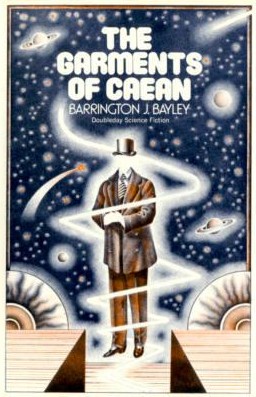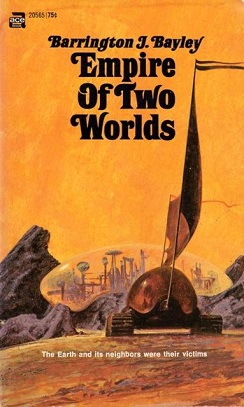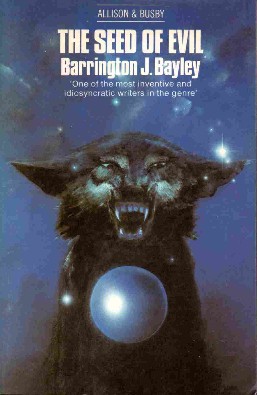
Donald Allen Wollheim was an American science fiction editor, publisher, writer, and fan. As an author, he published under his own name as well as under pseudonyms, including David Grinnell, Martin Pearson, and Darrell G. Raynor. A founding member of the Futurians, he was a leading influence on science fiction development and fandom in the 20th-century United States. Ursula K. Le Guin called Wollheim "the tough, reliable editor of Ace Books, in the Late Pulpalignean Era, 1966 and '67", which is when he published her first two novels in Ace Double editions.

Michael John Harrison, known for publication purposes primarily as M. John Harrison, is an English author and literary critic. His work includes the Viriconium sequence of novels and short stories (1971–1984), Climbers (1989), and the Kefahuchi Tract trilogy, which consists of Light (2002), Nova Swing (2006) and Empty Space (2012).
Barrington J. Bayley was an English science fiction writer.

The Centauri Device is the third novel by English author M. John Harrison. The novel, originally conceived as an "anti-space opera" would ultimately go on to make a major contribution to revitalising the subgenre and influencing the works of later authors such as Iain M. Banks and Alastair Reynolds.

The Garments of Caean is the seventh novel by the science fiction author Barrington J. Bayley. He described it as being his attempt to create a Vancian space opera.

The Pillars of Eternity is the tenth novel by the science fiction author Barrington J. Bayley.

Collision Course is the fourth novel by the science fiction author Barrington J. Bayley. The novel was inspired by the multiple time dimensions proposed by J. W. Dunne. The plot centers on the collision of two alternate "presents", with disastrous implications for reality.

The Fall of Chronopolis (ISBN 0-87997-043-X) is the fifth novel by the science fiction author Barrington J. Bayley. It details the eternal conflict through time between the Chronostatic Empire and its enemy, the Hegemony.

The Grand Wheel is the eighth science fiction novel by Barrington J. Bayley. The novel follows Cheyne Scarne, a professor of "randomatics", as he is selected by the eponymous organization to represent humanity in a card game with infinitely varying rules. The name of the main character appears to be a reference to John Scarne.

Annihilation Factor is the second science fiction novel by Barrington J. Bayley, expanded from a 1964 short story originally published in New Worlds. It centres on the strains placed on a galactic empire by the appearance of the mysterious, planet-devouring "patch".

Empire of Two Worlds is a science fiction novel by English writer Barrington J. Bayley. The main characters are "tankless" inhabitants of a dim and dry colony world who attempt to find a lost gateway back to Earth.

Star Winds is the ninth science fiction novel by Barrington J. Bayley. In the future Solar System of the novel, humans travel through space using solar sails and, as with much of Bayley's work, alchemy and other pseudosciences play a role alongside more conventional technology.

The Soul of the Robot is the sixth science fiction novel by Barrington J. Bayley, featuring the character Jasperodus from his 1956 story "Fugitive". The book tells of Jasperodus, the only robot with a soul, as he attempts to prove that he is the equal of the humans around him. It was published in 1974 by Doubleday, with a revised version published in 1976 by Allison and Busby.

The Seed of Evil is the second science fiction collection by Barrington J. Bayley. The book collects thirteen short stories published between 1962 and 1979, several of which are original to this volume.

The Rod of Light is the thirteenth science fiction novel by Barrington J. Bayley and his only sequel.

The Forest of Peldain is the twelfth science fiction novel by Barrington J. Bayley. Set on the water world of the Hundred Islands, the Arelian empire attempts to seize control of the last island, Peldain, which within its dense forests contains an independent kingdom and an ancient secret.

The Sinners of Erspia is the fifteenth science fiction novel by Barrington J. Bayley. The main character is the interstellar courier Laedo, who is stranded on the bizarre artificial planetoid Erspia. The novel focuses on his attempts to gain an understanding of Erspia and Erspia's creator, the god-like Klystar. The novel was completed in 1997 and was first published as a print-on-demand book in 2002.

The Zen Gun is the eleventh science fiction novel by Barrington J. Bayley.

The Knights of the Limits is the first science fiction collection by Barrington J. Bayley. The book collects nine short stories published between 1965 and 1978, one of which is original to this volume.

Vargo Statten Science Fiction Magazine was a British science fiction magazine which published nineteen issues between 1954 and 1956. It was initially published by Scion Press, with control passing to a successor company, Scion Distributors, after Scion went bankrupt in early 1954. At the end of 1954, as part payment for a debt, Scion Distributors handed control of the magazine to Dragon Press, who continued it for another twelve issues. E. C. Tubb and John Russell Fearn were regular contributors, and Kenneth Bulmer also published several stories in the magazine. Barrington Bayley's first published story, "Combat's End", appeared in May 1954. The editor was initially Alistair Paterson, but after seven issues Fearn took the helm: "Vargo Statten" was one of Fearn's aliases, and the magazine's title had been chosen because of his popularity. Neither Paterson nor Fearn had enough of a budget to attract good quality submissions, and a printing strike in 1956 brought an end to the magazine's life.



















